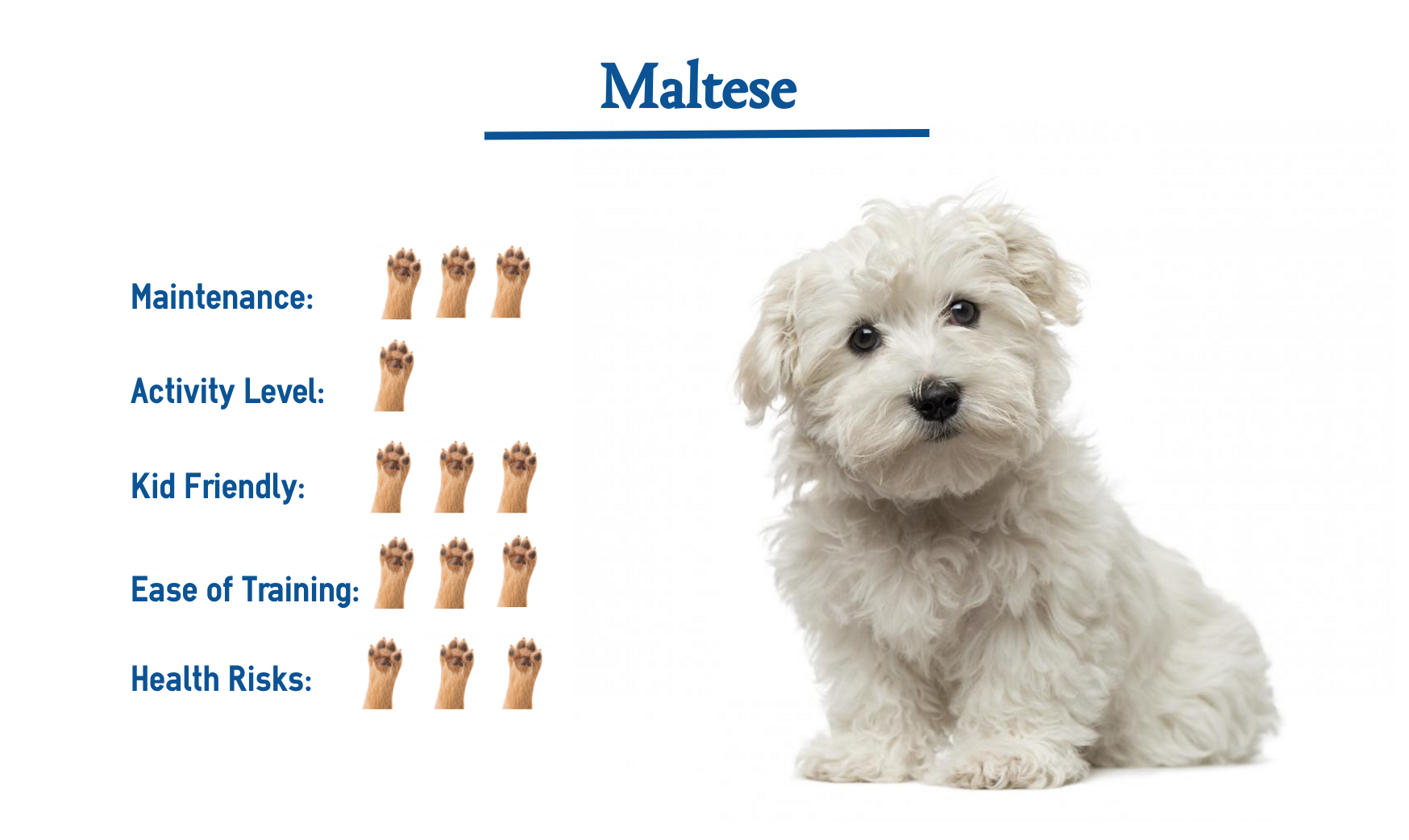Nowadays, it’s easy to find a reason to get upset with the world or make up an excuse to stay in bed all day, but we can tell you one thing: if you’re fortunate enough to have a Maltese in your life, chances are they are going to put a smile on your face every morning!
After all, look at these guys; it’s almost as though their “cheerful” little faces are saying…
“Smile, buddy; today will be a good day!”
And what more could you ask for in a companion animal? That said, however, like any dog breed, there are a few things you ought to know about them before you just run out and adopt a Maltese puppy or rescue dog, which is why we wanted to take a moment and write about what it might be like to own one of these bundles of joy. If you’re ever allowed to own one, you won’t be disappointed if you do.
So, without further ado, let’s dive right in!
Maltese Dog Fast Facts
Country of Origin: Malta
Original Purpose: Companion animal or lapdog
Height: 8 to 10 inches at the shoulder
Weight: 4 to 7 pounds
Dog Breed Classification: Toy dog
Life Span: 15 to 18 years
Origin of the Maltese Dog Breed
The Maltese is an ancient dog breed from the Island of Malta. And while he may look like a modern dog, he has been around for many years. Historical writings and evidence indicate that these little dogs have existed since 300 B.C. Back then, these little guys were known to the Greeks and the Romans as the Melitaie and were often traded for wine, olive oil, and other fine things because, even early on, folks saw the value of these little guys.
Particularly the…
Greek and Roman ladies who loved this dog. He made for a perfect playmate for them, something to occupy themselves with when they were alone at home while the men went off on military campaigns (those were different times back then). This is why the Maltese became known as a “comforter dog” or a therapy dog with tremendous healing powers. He had his uses, too: he got rid of all the fleas from the household, and since he is a bit suspicious of strangers, they make for pretty good watchdogs.
The first Maltese was brought to the United States in the 19th century. The American Kennel Club (AKC) recognized him in 1888. He remains a prevalent breed in the United States and abroad and is a favorite toy dog of the rich and the famous.
Physical Characteristics
The Maltese is a small dog, no more than 8 to 10 inches tall at the shoulder level. His small size makes him easy to carry around. He has a Spitz-like curling tail, beautiful eyes, and tiny ears. He is probably best known for his long, flowing, silky coat, usually pure white. He has long hair which can grow unchecked unless trimmed into a puppy clip. Like other small breeds, the Maltese is a high-maintenance dog requiring much grooming. His coat has to be tended to as often as possible; it can get matted and difficult to manage.
Temperament and Personality
The Maltese Lion Dog has always been a companion dog. He is not a working dog by any means. He is no guard dog and not a dog you can rely on to defend you against an attacker (not that he won’t try to help, but that’s a different thing.) But be warned, they tend to be suspicious and bark quite a lot, especially at strangers. It’s hard to stop him when he starts barking, but he is all bark and no bite – which is good.
He is a dog…
That demands to be loved and will give you a lot of love in return. He is an adorable little puppy who brings joy to your world and makes everyone around him happy. Loyal to a fault, these guys get attached to his family. He can suffer from separation anxiety when left alone for too long.
He is a sweet little dog that runs all around the house, follows you everywhere you go, and wants nothing more than to cuddle in your lap. How can you not fall in love with him at first sight?
Potential Health Concerns
The Maltese is one of the most miniature dog breeds but also one of the healthiest dogs. Most small breeds tend to have high life expectancy, which is the case with this dog as well – he has a life span of 15 to 18 years.
Just make sure that he doesn’t have more dog food than he should, as obesity is a serious concern with this breed, as is tear staining. Here is a list of health issues known to affect this breed.
- Patent ductus,
- Portosystemic shunts,
- Cryptorchidism,
- Patellar luxation,
- White shaker dog syndrome,
- Necrotizing meningoencephalitis.
And while not all of these conditions may not be life-threatening, they can indeed become quite expensive to deal with, particularly if they become recurring issues. This is why we here at IndulgeYourPet also recommend that any new pet owner take a moment and see what it might cost for you to purchase a pet insurance policy for your new animal.
Now, will a pet insurance policy be suitable for everyone?
No, probably not. But until you fully understand what these policies “will” and “won’t” cover and how much these pet insurance policies cost, how will you know if one might be right for you?
For more information on who we feel currently offers the “best” pet insurance policies out there, we would encourage you to check out our Best Pet Insurance Policies article.




I’m considering getting a male test pup and just wanted to be prepared. Can you give me a basic overview of what to look for and know what to do. Thanks